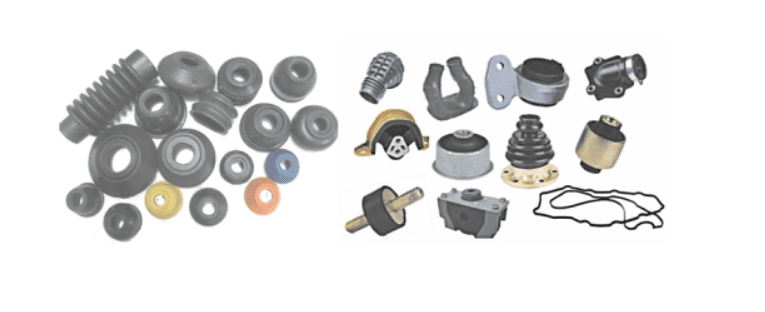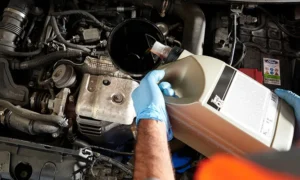Rubber components such as seals, hoses, mounts, and gaskets are vital to a vehicle’s performance, safety, and lifespan. They prevent leaks, absorb vibrations, and protect critical systems from heat, moisture, and dust. This article explains how automotive rubber components are produced, covering every stage from material selection and molding to finishing and quality control.
Automotive Rubber Component Manufacturing Guide
Here is how the automotive rubber components are manufactured:
-
Material Selection and Compound Formulation
The process of manufacturing automotive rubber components begins with careful material selection. The type of rubber chosen directly impacts the part’s performance.
Common materials include Nitrile Rubber (NBR), Ethylene Propylene Diene Monomer (EPDM), and Fluorocarbon (FKM), each selected for its specific properties such as chemical resistance, flexibility, and heat tolerance.
The rubber compound formulation involves blending these materials with additives like fillers, plasticizers, and curing agents to achieve the desired characteristics. This stage ensures that the rubber is capable of withstanding the harsh conditions typical in automotive systems.
-
Manufacturing Processes
Once we have the material selected and the compound formulated, here is how the manufacturing process looks:
-
Molding Techniques
Molding is a key method used to create parts with complex shapes, such as gaskets and seals. During molding, rubber is heated and pressed inside a mold to achieve the desired shape. Different molding techniques are used depending on the part design, including compression molding, transfer molding, and injection molding. Each method is optimized to suit the particular specifications of the part.
-
Extrusion
Extrusion technology is utilized to produce continuous rubber components, including hoses, tubing, and weather strips. The process involves feeding the rubber compound into an extruder, where it is heated and pressed through a precision die to form a uniform profile. After cooling, the material is cut to specific lengths, ensuring consistent geometry critical for flexible applications.
-
Vulcanization (Curing)
Vulcanization gives rubber its final performance characteristics. The process involves heating the molded or extruded rubber with sulfur or other curing agents, causing chemical cross-links between polymer chains.
This strengthens the material, improves elasticity, and enhances resistance to heat and wear. Proper vulcanization ensures that rubber components maintain their integrity and performance throughout their service life.
-
Post-Processing and Finishing
The post-processing and finishing stages have the following processes:
-
Deflashing/Trimming
Once a rubber component is molded or extruded, it often requires finishing to remove excess material, known as flash, that can form around the edges.
Deflashing involves removing this extra material to ensure the part has clean, smooth edges and meets the required dimensions.
Trimming may also be necessary to refine the shape and ensure the part fits perfectly in its intended assembly.
-
Bonding/Assembly
In some cases, rubber components must be bonded to other materials, such as metal or plastic. This can be achieved through adhesive bonding, co-molding, or mechanical fastening.
Bonding is essential for components like mounts, hoses, and seals, where a secure and reliable connection is needed to ensure proper functionality and safety in the vehicle.
-
Quality Control and Compliance
Before the auto rubber parts reach the assembly line, they undergo strict quality control and compliance checks.
-
Dimensional Inspection
Dimensional inspection uses high-accuracy tools, such as laser scanners and Coordinate Measuring Machines (CMMs), to verify that the parts meet strict size and shape specifications. This ensures each component integrates seamlessly with the vehicle’s systems.
-
Material Testing (ASTM/ISO)
Every batch of automotive rubber parts is tested for mechanical properties like hardness, tensile strength, and elongation. These tests follow global standards such as ASTM and ISO, confirming that the material can endure the mechanical stress, temperature, and chemical exposure it will face in real-world use.
-
Environmental Testing
Automotive rubber components must perform reliably under varying environmental conditions. Environmental testing includes exposure to heat, cold, humidity, and UV radiation to assess resistance to aging and degradation. This ensures the parts maintain their performance even after years of operation.
-
Regulatory Compliance (IATF 16949)
Compliance with IATF 16949 is essential in automotive manufacturing. This international standard outlines strict requirements for quality management systems specific to the automotive sector. It focuses on continuous improvement, defect prevention, and reducing variations in production and supply processes.
Reliable Rubber Injection Molding Machine Recommendation
To efficiently and sustainably manufacture industry-compliant automotive rubber components, you need high-performance rubber injection molding machines. Among all brands, Dekuma stands out as a trusted name, providing reliable machines that meet global quality standards.
Their RV, RV-Se, and RC series machines deliver stable injection pressure and superior clamping force. They are equipped with durable hydraulic systems and precision components sourced from leading international suppliers, which ensures minimal leakage and long-term operational stability. These machines come with the following features:
- Stable hydraulic and clamping systems ensure long-lasting performance.
- Modular design supports customization for various materials and product types.
- Energy-efficient drives reduce power consumption and emissions.
- iSee intelligent platform enables real-time monitoring and data analysis.
- User-friendly interface for quick setup and simplified operation.
- Suitable for seals, gaskets, window trims, and vibration-damping parts.
- Reliable turnkey support, including mold design, training, and after-sales service.
Wrapping Up
The manufacturing of automotive rubber components demands accuracy, innovation, and dependable technology. Dekuma delivers on all three. With 20+ years of expertise and 30+ innovative patents, it manufactures advanced rubber injection molding machines that combine intelligent control, energy efficiency, and precision engineering.
Its solutions are trusted by global brands, including SINOTRUK and DRB. If you are looking for a reliable partner for your rubber part manufacturing equipment, Dekuma may be the ideal choice. For more information, feel free to contact them here!
Read More From Techbullion



































